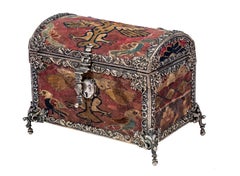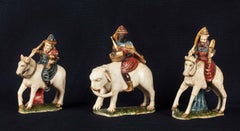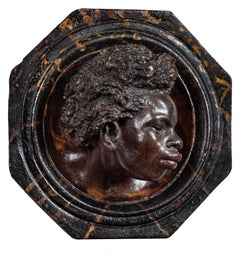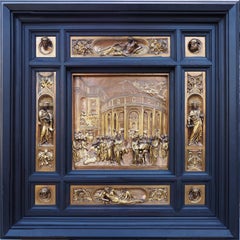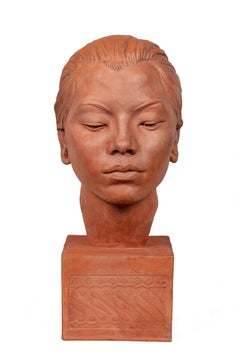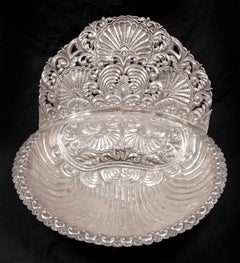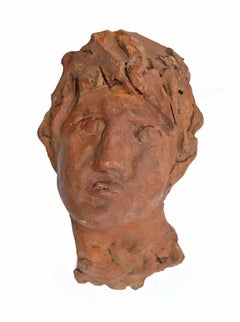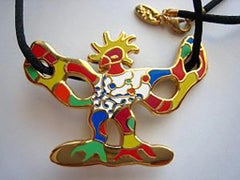Robert Simon Fine Art Sculptures
to
6
2
1
Overall Width
to
Overall Height
to
5
3
1
1
3
1
5
3
2
2
2
2
1
1
1
1
1
1
1
1
1
1
1
1
1
1
3
3
3
2
2
2
1
9
Silver and Transitional Andean Textile Casket
By Spanish Colonial (Peruvian)
Located in New York, NY
Silver was the material of choice for both ecclesiastical and domestic vessels in the New World, not only for its status as a precious metal, but also because of its abundance and du...
Category
Early 18th Century Sculptures
Materials
Silver
The Three Magi
Located in New York, NY
Provenance: Private Collection, Spain.
Known as Peruvian alabaster for its translucency and workability, Piedra de Huamanga is a highly prized material from the province of Ayacucho in Peru. In the 17th and 18th centuries, local craftsman in the town of Huamanga began to specialize in the production of small-scale, polychrome religious sculptures made from this distinctive stone. Huamanga sculptures are among the most accomplished examples of carving from the Spanish Americas, where polychrome wood sculpture was a far more common sculptural medium. These works, which were created as independent sculptures or as sculptural groups—such as our three Magi—were intended for ecclesiastical as well as domestics settings.
Our three figures likely formed part of a larger Nativity group—a New World variant of the tradition of the Neapolitan Crèche...
Category
Late 18th Century Figurative Sculptures
Materials
Alabaster
Head of a Young African Man
Located in New York, NY
Provenance: Private Collection, Spain.
This intriguing and enigmatic sculpture depicts the head of a young African man emerging from a circular opening ...
Category
Early 1800s Figurative Sculptures
Materials
Terracotta
The Story of Joseph from the Second Baptistery Doors, Florence (“The Gates of Pa
By Ferdinand Barbedienne
Located in New York, NY
Ferdinand Barbedienne (Saint-Martin-de-Fresnay 1810 – 1892 Paris) after Lorenzo Ghiberti (Florence, 1378 – 1455)
Signed at the lower right of the principal relief: F. BARBEDIENNE
Provenance: Private Collection, USA.
Barbedienne’s “Gates of Paradise” reliefs are one of the triumphs of nineteenth-century bronze casting and patination. The nine panels that comprise our example are half-size reductions of the famous originals by Lorenzo Ghiberti, made for the Baptistery of Florence and now housed in the Museo del Opera del Duomo. Mounted in an impressive, mullioned frame surround, our work is an exceptional exemplar of the Renaissance Revival, the broadly influential style and movement that infused architecture, design, and artistic culture in the latter half of the nineteenth century.
The central scene, The Story of Joseph, is perhaps the most celebrated of the entire series depicting as it does seven episodes from the Biblical narrative integrated into a single composition: Joseph cast by his brethren into the well, Joseph sold to the merchants, the merchants delivering Joseph to the pharaoh, Joseph interpreting the pharaoh’s dream, the pharaoh paying him honor, Jacob sending his sons to Egypt, and Joseph recognizes his brothers and returns home. The surrounding reliefs—two vertical figures in niches, two recumbent figures, and four portrait heads in roundels—are as well faithful reductions of Ghiberti’s original bronzes on other parts of the doors.
The maker of these casts was the renowned 19th-century French fondeur Ferdinand Barbedienne. Gary Radke has recently written of this great enterprise:
“The Parisian bronze caster Ferdinand Barbedienne began making half-sized copies of ancient and Renaissance sculpture in the 1830s. His firm benefitted enormously from the collaboration of Achille Collas, whom Meredith Shedd has shown was one of numerous pioneers in the mechanical reproduction of sculpture. Their competitors largely devoted themselves to reproducing relief sculpture, but Collas devised a process for creating fully three-dimensional copies. A tracing needle, powered by a treadle, moved over the surface of a full-sized plaster cast or bronze of the original and triggered a complementary action in a cutting stylus set over a soft plaster blank…He signed an exclusive contract with Barbedienne on November 29, 1838, and won medals for his inventions in 1839 and 1844.
Barbedienne’s half-sized copies of the Gates of Paradise were famous not only for their fidelity to the original, but also for the way their gilding…suggested the glimmering surface that was hidden under centuries of dirt. Some critics even saw Collas’s and Barbedienne’s work as ‘philanthropic, an exemplary adaptation of industry to the requirements of art, the artist, the workers, and the public alike.’
At 25,000 francs, Collas’s and Barbedienne’s reduction of the Gates of Paradise was singularly more expensive than any other item for sale in their shop. All the reliefs, individual statuettes, and busts were cast separately and could be purchased either by the piece or as an ensemble. Fittingly, Barbedienne’s accomplishment earned him the Grand Prix at the 1878 Paris Exposition Universelle, along with numerous other medals.”
Three complete examples of the Barbedienne-Ghiberti doors are known. One, first installed in a chapel in the Villa Demidoff of San Donato near Pratolino, was later acquired by William Vanderbilt...
Category
Late 19th Century Figurative Sculptures
Materials
Bronze
Portrait of Ni-Polog
Located in New York, NY
Signed, dated, and inscribed on the verso:
Malvina Hoffman/ Den Pasar/ “Nipolog”-/ © 1932/ Bali
Provenance:
The artist; her estate.
Literature:
Mal...
Category
1930s Realist Sculptures
Materials
Terracotta
Cuzco School Baptismal Dish
By Spanish Colonial (Peruvian)
Located in New York, NY
Provenance:
Manuel Ortíz de Zevallos y García, Peru; and by descent in the family to:
Private Collection, New York.
This impressive baptismal dish is an example of eighteenth-cent...
Category
18th Century Old Masters Sculptures
Materials
Silver
First Journey
Located in New York, NY
Provenance: Sables de Fontainbleau, Seine-et-Marne, France
“Gogottes” are natural creations formed out of sands deposited in Northern France during the Oligocene Period, approximately 30 million years ago. Much later, in a process that has only recently become understood, groundwater rich in silica flowed through the sands...
Category
15th Century and Earlier Naturalistic Abstract Sculptures
Materials
Sandstone
The Infant Saint John the Baptist with a Lamb
Located in New York, NY
Provenance:
James Byrnes, Los Angeles (1917-2011)
Giusto Le Court was born Josse or Justus de Corte in the Flemish city of Ypres. His father Jean was a sculptor and presumably his earliest training was with him before he entered the studio of Cornelis van Mildert. The young artist was clearly influenced by the dominant Flemish sculptor of the time, Artus Quellinus the Elder, with whom he may have worked on the decoration of the Amsterdam City Hall.
Following the lead of many northern artists he travelled to Rome, perhaps more than once, before settling in Venice around 1655. It was there, as one of a colony of expatriate artists, that he made his name as a sculptor. One of his first Venetian commissions was for the monument to Alvise Mocenigo in the Church of San Lazzaro dei Mendicanti, where Le Court sculpted the marble figures of Strength and Justice. He also collaborated with the celebrated architect Baldassare Longhena, most famously for the high altar of Santa Maria della Salute, where he carved the multi-figured altarpiece depicting the Queen of Heaven Expelling the Plague.
The present marble sculpture depicts the infant Saint John the Baptist, reclining, wearing his traditional hair-shirt, embracing a lamb, and holding the bottom of his attribute, a reed cross. Attached to his shirt is a baptismal cup, with which he would become associated later in his life. Veneration of the infant Saint John the Baptist was prevalent throughout Italy and images of the saint in childhood—often called “Giovannino,” or little John...
Category
17th Century Renaissance Sculptures
Materials
Marble
Moroccan, Fez or Meknes: Tall bowl (Jobbana) with geometric designs
Located in New York, NY
Provenance:
Collection of Emily Johnston De Forest and Robert Weeks De Forest, New York, by 1911-until 1942; thence by descent until 2018.
Literature: ...
Category
1810s Sculptures
Materials
Earthenware, Tin Glaze
Related Items
Portrait - Sculpture by Sirio Pellegrini - 1960s
Located in Roma, IT
Painted Terracotta sculture realized by Sirio Pellegrini in 1960s.
Good condition.
Sirio Pellegrini, born in Rome on March 1, 1922, of Abruzzo origins (Capestrano), spent his child...
Category
1960s Modern Figurative Sculptures
Materials
Terracotta
$2,610
H 6.7 in W 4.34 in D 2.76 in
Brooch Oiseau (Bird) Zamak, gold tone finished, nickel free (Incised Signature)
By Niki de Saint Phalle
Located in New York, NY
Niki de Saint Phalle
Brooch (Oiseau), ca. 2005
Zamak, gold tone finished, nickel free (Incised Signature)
Incised signature on the back of the jewelry (Niki De Saint Phalle) and the clasp (Niki).
2 3/10 × 1 3/5 inches
Authorized by the Estate of Niki de Saint Phalle!
This colorful, whimsical piece - "Oiseau" (Bird) can be worn both as a brooch and as a necklace. Bears the Niki de Saint Phalle's incised signature. Collectible work. Makes a terrific gift.
Biography of Niki de Saint Phalle
Childhood
Niki de Saint Phalle was born in France in 1930 to an aristocratic Catholic family. She had an American mother, a French banker father, four siblings, and grew up bilingual in French and English. Her father lost his wealth during the Great Depression and the family moved to the US in 1933, where Saint Phalle attended Brearley School, a girls' school in New York City. Saint Phalle reported later in her life, in an autobiography titled Mon Secret (1994), that her father had sexually abused her from age 11.
From an early age, Saint Phalle pushed boundaries in her artistic and personal life. Though she found Brearley School to be a formative experience, later claiming that it was there she became a feminist, she was expelled for painting the fig leaves covering the genitals of statues on the school's campus red. She then attended Oldfields School in Maryland, graduating in 1947. As a young woman, Saint Phalle also worked as a model, appearing on the front covers of Life Magazine and Vogue.
When she was 18, Saint Phalle eloped with Henry Matthews, an author and childhood friend. While Matthews studied music at Harvard University, Saint Phalle began to explore painting, and gave birth to her daughter Laura in 1951, when she was 20 years old.
Early Training and work
In 1952, the Matthews and Saint Phalle moved to Paris, where he continued to study music and Saint Phalle studied theater. The couple traveled extensively in Europe, gaining exposure to art by the Old Masters. The following year, Saint Phalle was diagnosed with a "nervous breakdown" and hospitalized in a psychiatric facility. She was encouraged to paint as a form of therapy, and consequently gave up her theater studies in favor of becoming an artist.
The couple moved to Mallorca off the coast of Spain, where their son Philip was born in 1955. During this time, Saint Phalle developed her imaginative, self-taught style of painting, experimenting with a variety of forms and materials. She also discovered the architecture of Antonio Gaudi, which had a strong influence on her work. Gaudi's Park Guell in Barcelona was instrumental in Saint Phalle's early conceptualization of the elaborate sculpture garden she would fulfill much later in her career.
Mature Period
At the end of the 1950s, Saint Phalle and her husband moved back to Paris. In 1960, however, the couple separated and Saint Phalle moved to a new apartment, established a studio, and met artist Jean Tinguely, with whom she would collaborate artistically. Within a year, they had moved in together and begun a romantic relationship.
Saint Phalle became part of the Nouveau Réalisme movement along with Tinguely, Yves Klein, Arman and others. She was the only woman in the group. Her first solo exhibition in 1961 punctuated a dynamic period of Saint Phalle's early career, and she met a number of influential artists living in Paris at the time, such as Robert Rauschenberg and Jasper Johns, whose use of found objects was to have a strong influence on Saint Phalle's work. She was also friendly with Marcel Duchamp, who first introduced her and Tinguely to Salvador Dalí. The three artists traveled to Spain together to an event celebrating Dali's work, in which a life-sized bull sculpture was detonated with fireworks.
In 1963, Tinguely and Saint Phalle moved to an old house just outside Paris, where she began to work on architectural projects as well as her renowned shooting...
Category
Early 2000s Contemporary Abstract Sculptures
Materials
Metal, Gold, Enamel
$550
H 2.3 in W 1.6 in D 0.3 in
Antique Italian sculptor - 18/19th century terracotta sculpture - Memento Mori
Located in Varmo, IT
Terracotta sculpture - Memento mori. Italy, 18th-19th century.
16 x 25 x h 18 cm.
Entirely in terracotta.
- This item is sold with a certificate of authenticity with legal validi...
Category
Late 18th Century Old Masters Figurative Sculptures
Materials
Terracotta
$2,610 Sale Price
21% Off
H 7.09 in W 6.3 in D 9.85 in
Large Lying Figure I by Pierre Yermia - Bronze sculpture, nude woman statue
By Pierre Yermia
Located in Paris, FR
Large Lying Figure I is a bronze sculpture by French contemporary artist Pierre Yermia, dimensions are 46 × 120 × 17 cm (18.1 × 47.2 × 6.7 in).
The sculpture is signed and numbered...
Category
2010s Contemporary Figurative Sculptures
Materials
Bronze
$13,126
H 18.12 in W 47.25 in D 6.7 in
"Against Winds and Tides" in Brittany by Isabelle LEVESQUE
By Isabelle Levesque
Located in Pasadena, CA
Levesque Isabelle was born in 1954 in Antananarivo. She attended the school of fine arts of Brest (France) and practiced sculpture since 1997. She made her first official exhibition ...
Category
21st Century and Contemporary Modern Figurative Sculptures
Materials
Bronze
$3,326 Sale Price
20% Off
H 10.24 in W 5.91 in D 5.91 in
Cockatoo
By Edouard-Marcel Sandoz
Located in PARIS, FR
Cockatoo
Head turned to the right, with a raised and spread out crest
by Edouard-Marcel SANDOZ (1881-1971)
A bronze sculpture with a dark brown patina nuanced with green
Signed on t...
Category
1930s Art Deco Figurative Sculptures
Materials
Bronze
Portrait of a Lady in White Chemise, Russet & Blue Drapery c.1695, Oil Painting
By Harman Verelst
Located in London, GB
This lavish portrait, painted circa 1695, is an exquisite example of the type of portrait in vogue during the last quarter of the seventeenth century. It is evident that the artist ...
Category
17th Century Old Masters Portrait Paintings
Materials
Canvas, Oil
$8,027
H 29.14 in W 24.41 in D 1.58 in
Catrina en Día de Muertos - Ceramic Sculpture - Mexican Folk Art - Cactus Fine A
By Alvaro de la Cruz Lopez
Located in Jesus del Monte, MX
MASTERPIECE
Made with natural ceramic. Hand-modeled technique and cooked in a wood-fired oven.
LISTING
===================================
1 Ceramic Catrina
=======================...
Category
2010s Realist Figurative Sculptures
Materials
Clay
Oil Portrait of a Victorian Lady, c. 1850
Located in Chicago, IL
Painted in the 19th century, this exquisite miniature portrait wonderfully exemplifies realism in traditional oil painting. The small artwork is painted in the conventional portraiture style of the Old Masters, and achieves soft realism with fine brushwork and a subdued, neutral palette. The half length portrait depicts a fine Victorian woman dressed in all black with a delicate lace collar and bonnet. She wears a ruby broach...
Category
Mid-19th Century Old Masters More Art
Materials
Oil
Portrait of a Gentleman, Doublet & White Ruff, Gloves Inscribed 1624, on panel
By Frans Pourbus the Younger
Located in London, GB
Titan Fine Art presents this exquisite oil on panel portrait depicting a handsome young gentleman in an exuberant black damask doublet. The pose, with one hand holding gloves and the other akimbo, was one that was well-established for gentleman of the upper echelons of society by the time this work was painted. The principle governing portraits at this time was the recording and defining in visual terms of the position of a sitter in society. In addition to brilliant and complex symbols of luxury, they often contained many symbolic elements too; the inclusion of gloves was often used in portraits that celebrated a betrothal as in ancient times gloves were used to seal a marriage contract.
The extraordinary costume of a black shimmering doublet, the brilliant white reticella ruff, and the cuffs edged with lace were immensely costly… this attire proclaims to every onlooker that this is a superior being. The rendering of the reticella lace ruff is exquisite and the artist has recorded the design that runs through the black damask fabric with meticulous attention to detail. The preservation of this black pigment is remarkable considering the age of the work. Black pigments are especially vulnerable to fade and wear over time partly due to environmental condition but also from unprofessional cleaning. This work is an exquisite example from the period.
According to the inscription in the upper right, the gentleman was in his 22nd year of age in 1624. The coat of arms, which is displayed without a crest, may be ‘blazoned’ in the language of heraldry, as: Sable on a Chevron between in chief two Roundels and in base a Billet [or possibly Square] Or three Martlets Sable. In plainer English this means a black (Sable) background, spanned by a gold (Or) chevron, above which are two golden solid circles (Roundels), and below which is a gold rectangle (Billet); on the chevron are three small black birds (Martlets). Martlets are a stylised form of heraldic bird, believed to be based on the swift, which are conventionally drawn with small tufts instead of feet. In Continental Europe it is also conventional for them to be drawn without beaks, as appears to be the case here. The birds in this instance also have a vaguely duck-like appearance.
Five families have been identified with very close armorial bearings to the one in our portrait. They are the (van) Houthem’s (of Brabant), the Prévinaire’s (of Flanders and Holland), and the Proveneer’s (of Liège) and it must be noted that the locations of these families also fit with the painting’s Flemish origins. However the French Grenières’s (of Île-de-France) and the Jallot’s (of Normandy) are the next closest matches and plausible matches, as Frans Pourbus had settled in Paris just a few years before our portrait was painted.
This painting has been assessed by a professional conservator prior to going on sale, and as thus, it can be hung and enjoyed immediately.
Frans Pourbus the Younger...
Category
17th Century Old Masters Portrait Paintings
Materials
Oil, Wood Panel
$18,320
H 42.13 in W 31.11 in D 3.94 in
Crepis Bronze Sculpture Nude Boy Male Figure Marble Stone
By Wim van der Kant
Located in Utrecht, NL
Crepis Bronze Sculpture Nude Boy Male Figure Marble Stone
Wim van der Kant (1949, Kampen) is a selftaught artist. Next to his busy profession as a teacher at...
Category
21st Century and Contemporary Contemporary Nude Sculptures
Materials
Marble, Bronze
$16,313
H 17.72 in W 7.88 in
Aestus Bronze Sculpture Marble Stone Nude Boy Contemporary
By Wim van der Kant
Located in Utrecht, NL
Aestus Bronze Sculpture Marble Stone Nude Boy Contemporary
Wim van der Kant (1949, Kampen) is a selftaught artist. Next to his busy profession as a teacher ...
Category
21st Century and Contemporary Contemporary Nude Sculptures
Materials
Marble, Bronze
$18,000
H 20.87 in W 3.94 in
